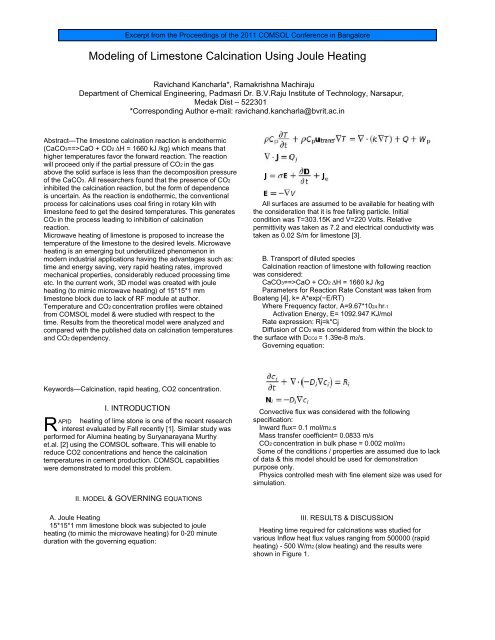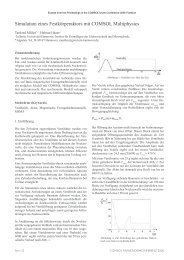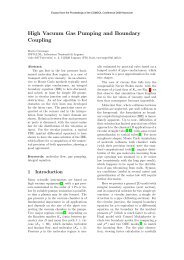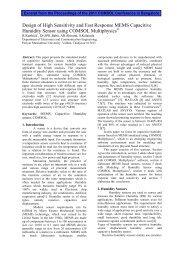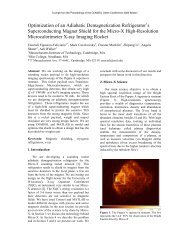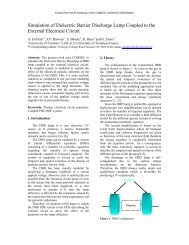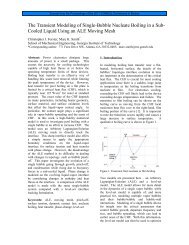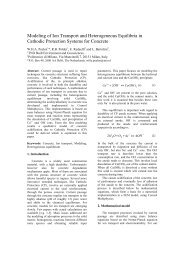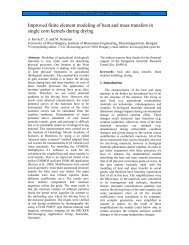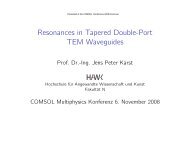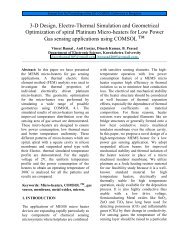Modeling of Limestone Calcination Using Joule ... - COMSOL.com
Modeling of Limestone Calcination Using Joule ... - COMSOL.com
Modeling of Limestone Calcination Using Joule ... - COMSOL.com
Create successful ePaper yourself
Turn your PDF publications into a flip-book with our unique Google optimized e-Paper software.
<strong>Modeling</strong> <strong>of</strong> <strong>Limestone</strong> <strong>Calcination</strong> <strong>Using</strong> <strong>Joule</strong> Heating<br />
Ravichand Kancharla*, Ramakrishna Machiraju<br />
Department <strong>of</strong> Chemical Engineering, Padmasri Dr. B.V.Raju Institute <strong>of</strong> Technology, Narsapur,<br />
Medak Dist – 522301<br />
*Corresponding Author e-mail: ravichand.kancharla@bvrit.ac.in<br />
Abstract—The limestone calcination reaction is endothermic<br />
(CaCO3==>CaO + CO2 ∆H = 1660 kJ /kg) which means that<br />
higher temperatures favor the forward reaction. The reaction<br />
will proceed only if the partial pressure <strong>of</strong> CO2 in the gas<br />
above the solid surface is less than the de<strong>com</strong>position pressure<br />
<strong>of</strong> the CaCO3. All researchers found that the presence <strong>of</strong> CO2<br />
inhibited the calcination reaction, but the form <strong>of</strong> dependence<br />
is uncertain. As the reaction is endothermic, the conventional<br />
process for calcinations uses coal firing in rotary kiln with<br />
limestone feed to get the desired temperatures. This generates<br />
CO2 in the process leading to inhibition <strong>of</strong> calcination<br />
reaction.<br />
Microwave heating <strong>of</strong> limestone is proposed to increase the<br />
temperature <strong>of</strong> the limestone to the desired levels. Microwave<br />
heating is an emerging but underutilized phenomenon in<br />
modern industrial applications having the advantages such as:<br />
time and energy saving, very rapid heating rates, improved<br />
mechanical properties, considerably reduced processing time<br />
etc. In the current work, 3D model was created with joule<br />
heating (to mimic microwave heating) <strong>of</strong> 15*15*1 mm<br />
limestone block due to lack <strong>of</strong> RF module at author.<br />
Temperature and CO2 concentration pr<strong>of</strong>iles were obtained<br />
from <strong>COMSOL</strong> model & were studied with respect to the<br />
time. Results from the theoretical model were analyzed and<br />
<strong>com</strong>pared with the published data on calcination temperatures<br />
and CO2 dependency.<br />
Keywords—<strong>Calcination</strong>, rapid heating, CO2 concentration.<br />
R<br />
I. INTRODUCTION<br />
APID heating <strong>of</strong> lime stone is one <strong>of</strong> the recent research<br />
interest evaluated by Fall recently [1]. Similar study was<br />
performed for Alumina heating by Suryanarayana Murthy<br />
et.al. [2] using the <strong>COMSOL</strong> s<strong>of</strong>tware. This will enable to<br />
reduce CO2 concentrations and hence the calcination<br />
temperatures in cement production. <strong>COMSOL</strong> capabilities<br />
were demonstrated to model this problem.<br />
II. MODEL & GOVERNING EQUATIONS<br />
A. <strong>Joule</strong> Heating<br />
15*15*1 mm limestone block was subjected to joule<br />
heating (to mimic the microwave heating) for 0-20 minute<br />
duration with the governing equation:<br />
All surfaces are assumed to be available for heating with<br />
the consideration that it is free falling particle. Initial<br />
condition was T=303.15K and V=220 Volts. Relative<br />
permittivity was taken as 7.2 and electrical conductivity was<br />
taken as 0.02 S/m for limestone [3].<br />
B. Transport <strong>of</strong> diluted species<br />
<strong>Calcination</strong> reaction <strong>of</strong> limestone with following reaction<br />
was considered:<br />
CaCO3==>CaO + CO2 ∆H = 1660 kJ /kg<br />
Parameters for Reaction Rate Constant was taken from<br />
Boateng [4], k= A*exp(−E/RT)<br />
Where Frequency factor, A=9.67*1024 hr-1<br />
Activation Energy, E= 1092.947 KJ/mol<br />
Rate expression: Rj=k*Cj<br />
Diffusion <strong>of</strong> CO2 was considered from within the block to<br />
the surface with DCO2 = 1.39e-8 m2/s.<br />
Governing equation:<br />
Convective flux was considered with the following<br />
specification:<br />
Inward flux= 0.1 mol/m2.s<br />
Mass transfer coefficient= 0.0833 m/s<br />
CO2 concentration in bulk phase = 0.002 mol/m3<br />
Some <strong>of</strong> the conditions / properties are assumed due to lack<br />
<strong>of</strong> data & this model should be used for demonstration<br />
purpose only.<br />
Physics controlled mesh with fine element size was used for<br />
simulation.<br />
III. RESULTS & DISCUSSION<br />
Heating time required for calcinations was studied for<br />
various Inflow heat flux values ranging from 500000 (rapid<br />
heating) - 500 W/m2 (slow heating) and the results were<br />
shown in Figure 1.
5*105<br />
W/m2<br />
5*104<br />
W/m2<br />
5*103<br />
W/m2<br />
5*102<br />
W/m2<br />
Figure 1. Temperature pr<strong>of</strong>ile with Heat influx variation.<br />
Duration was found to be in the range <strong>of</strong> 1s to 1200s.<br />
Incase <strong>of</strong> slow heating the temperature was uniform through<br />
out the slab. It was also observed that the temperature pr<strong>of</strong>ile<br />
was changing very rapidly at higher flux values & hence an<br />
inflow heat flux in the range <strong>of</strong> 500-5000 W/m2 was<br />
suggested for actual experiments.<br />
Concentration pr<strong>of</strong>iles were also captured for the above<br />
case study (Figure 2) and found that the CO2 concentration is<br />
leading to uniform value equal to 0.014 mol/m3.<br />
5*105 W/m2<br />
5*104 W/m2<br />
5*103 W/m2<br />
Figure 2. Concentration pr<strong>of</strong>ile with Heat influx variation.<br />
It was found that the temperature calculations are not very<br />
sensitive to step size and the model was converging with a<br />
step size <strong>of</strong> 0.10C also with an accurate solution. However,<br />
Concentration calculation found to be sensitive and even the<br />
<strong>com</strong>putation time was considerable.<br />
IV. CONCLUSION<br />
<strong>COMSOL</strong> capabilities to model limestone calcinations was<br />
demonstrated using two physics namely <strong>Joule</strong> heating and<br />
Transport <strong>of</strong> diluted species. Experimental investigations<br />
should be carried out based on the inputs from the <strong>COMSOL</strong><br />
model. <strong>Joule</strong> heating is showing a temperature pr<strong>of</strong>ile across
the slab & hence the study <strong>of</strong> microwave heating suggested.<br />
V. REFERENCES<br />
[1] Fall W, S. M. Allan, H. S. Shulman, “Rapid limestone<br />
calcination using Microwave Assist Technology”, 35rd<br />
International Conference & Exposition on Advanced<br />
Ceramics and Composites ICACC-S8-023-2011.<br />
[2] Suryanaraya Murthy P, Srinath M S, Sharma A K,<br />
Pradeep Kumar, “An FEM approach to analysis <strong>of</strong><br />
microwave heating <strong>of</strong> alumina in Multi-mode applicator”,<br />
Int. Conference on Mathematical modeling and<br />
applications to industrial problems, NIT Calicut, March<br />
28-31, 2011.<br />
[3] Grégoire, Colette, Joesten, P.K., and Lane, J.W. Jr., 2007,<br />
Use <strong>of</strong> borehole-radar methods to monitor a steam-<br />
enhanced remediation pilot study at a quarry at the former<br />
Loring Air Force Base, Maine: U.S. Geological Survey<br />
Scientific Investigations Report 2006–5191, 35 p.<br />
[4] Boateng Akwasi A., Rotary Kilns-Transport Phenomena<br />
and Transport Processes, page-277, Butterworth-<br />
Heinemann Elsevier (2008)<br />
ACKNOWLEDGMENT<br />
Authors would like to thank the management <strong>of</strong> Padmasri<br />
Dr. B. V. Raju Institute <strong>of</strong> Technology for providing the<br />
Simulation laboratory facilities.


